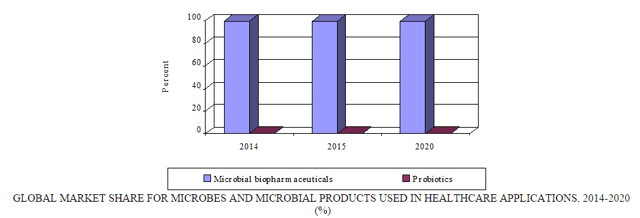
Dec 10, 2015
Blog Life Sciences Microbial Biopharmaceuticals Market Analysis
A microbe is a minute living organism, such as a bacterium, yeast, or fungus. The first commercial applications of microbes date back to around 1750 BC, when the ancient Sumerians used yeast to brew beer. Microbes were used for centuries to produce bread, wine, vinegar and other common products -- without anyone knowing the scientific basis for the ingredient.
Today, genetically engineered microbes are used for the commercial production of nonmicrobial products such as insulin, interferon, human growth hormone, and viral vaccines. Microbes are also used to produce energy (e.g., biodiesel and bioethanol) and to clean up environmental pollutants such as sewage and oil spills. As the active ingredient in biofertilizers and biopesticides, microbes contribute to increasing agricultural productivity, and microbes form the basis of cost-effective methods of mining and metallurgy.
According to BCC Research's Microbial Products: Technologies, Applications, and Global Markets (BIO086C), the total global market for microbes and microbial products was worth nearly $143.5 billion in 2014. The 2015 market is projected to approach $154.7 billion, and the 2020 market, nearly $306 billion. These figures work out to a 14.6% projected compound annual growth rate (CAGR) between 2015 and 2020.
Most of this market consists of products such as biopharmaceuticals and biofuels, made using yeasts, bacteria and other microbes. BCC Research identified markets for microbes (e.g., biofertilizers, biopesticides and probiotics) that totaled nearly $3.4 billion in 2014. The market for microbes is projected to approach nearly $3.7 billion in 2015 and $5.9 billion in 2020.
Healthcare was the largest end-user market for microbes and microbial products at some $100.4 billion in 2014, increasing to nearly $111.5 billion in 2015, and over $187.8 billion in 2020. The large size of the healthcare market reflects the importance of microbe-based biopharmaceuticals.
Energy was the second-largest end-user sector at $25.2 billion in 2014. However, this sector is expected to decline to $22.6 billion in 2015 due to falling ethanol prices then increase to nearly $74.4 billion by 2020. Manufacturing is the third-largest sector of the market, with sales of nearly $15.7 billion in 2014, $18.2 billion in 2015 and over $40.0 billion in 2020.
Agricultural and environmental applications of microbes and microbial products, while large in absolute terms, account for relatively small shares of the overall market.
 Source: BCC Research, "Microbial Products: Technologies, Applications and Global Markets," September, 2015
Source: BCC Research, "Microbial Products: Technologies, Applications and Global Markets," September, 2015
HEALTHCARE AND BIOPHARMACEUTICALS
The global market for microbes and microbial products used in healthcare applications is moving at a significant five-year CAGR of 11%.
Biopharmaceuticals (i.e., pharmaceutical products produced using microbes) account for more than 99% of the this market. Microbes that are ingested directly, while significant in absolute terms (approximately $446 million in 2014, increasing to $825.2 million by 2020), have less than a 1% market share.
Biopharmaceuticals are drugs produced using biotechnology. Microbial cells produce most biopharmaceuticals, although mammalian or plant cells or moss plants produce some.
The majority of approved microbial biopharmaceuticals are produced in microbes that have been bioengineered by recombinant DNA means (i.e., genetic engineering). Examples include the production of insulin in recombinant E. coli and S. cerevisiae.
Genentech pioneered the use of E. coli to produce human insulin in 1978. Prior to the development of this technique, insulin was extracted from the pancreas glands of cattle, pigs, and other farm animals. While generally effective in the treatment of diabetes, animal-derived insulin has chemical differences from human insulin, which may produce allergic reactions in some people.
Genentech researchers produced artificial genes for each of the two protein chains that comprise the insulin molecule. The artificial genes were then inserted into plasmids (small rings of DNA that bacteria pass to one another in a primitive form of sex).
When a sample of bacteria is “infected” with the plasmid, some of the bacteria take up the plasmid and incorporate the new gene into their DNA. To separate the infected from the uninfected, the plasmid also contains a gene giving the bacteria immunity to a certain antibiotic. By treating the sample with the antibiotic, all of the cells that did not take up the plasmid are killed. What remains is a strain of insulin-producing E. coli that can be cultured in bulk to produce commercial quantities of insulin.
Other therapeutic agents produced using recombinant technology include blood proteins, immune modulators and veterinary pharmaceuticals such as bovine growth hormone. In 2013, the French pharmaceutical company Sanofi announced that its researchers had successfully engineered a strain of baker’s yeast capable of producing malaria drugs on an industrial scale.
In 2014 the global biopharmaceuticals market was worth an estimated $200 billion, of which approximately half ($100 billion) was produced by microbes. Industry sources expect this market to grow at a CAGR of 11%, reaching $111 billion in 2015 and $187 billion by 2020.
In today’s fast-paced biomedical world, researchers and pharmaceutical companies...

Radiopharmaceuticals represent a cutting-edge frontier in modern medicine, offer...

Implantable Remote Patient Monitoring (IRPM) devices are revolutionizing healthc...

We are your trusted research partner, providing actionable insights and custom consulting across life sciences, advanced materials, and technology. Allow BCC Research to nurture your smartest business decisions today, tomorrow, and beyond.
Contact UsBCC Research provides objective, unbiased measurement and assessment of market opportunities with detailed market research reports. Our experienced industry analysts assess growth opportunities, market sizing, technologies, applications, supply chains and companies with the singular goal of helping you make informed business decisions, free of noise and hype.